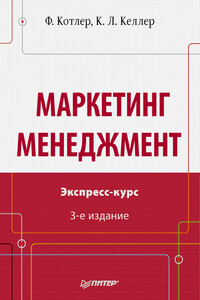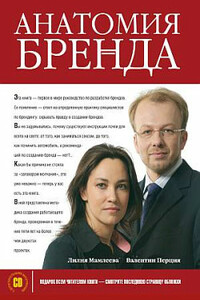Маркетинг 3.0: от продуктов к потребителям и далее – к человеческой душе [заметки]
1
Прообразом термина «технология новой волны» был термин «компьютерные технологии пятой волны», использованный в статье Copeland M. V., Malik O. How to Ride the Fifth Wave // Business 2.0. – 2005. – July.
2
Baker S., Green Н. Social Media Will Change Your Business // Business Week. – 2008. – February 20.
3
Murray R. A Corporate Guide to the Global Blogosphere: The New Model of Peer-to-Peer Communications. – Edelman, 2007.
4
Johnson S. How Twitter Will Change the Way We Live // Time. – 2009. – June 15.
5
Murray R. A Corporate Guide to the Global Blogosphere: The New Model of Peer-to-Peer Communications. – Edelman, 2007.
6
Baker S. What's A Friend Worth? // BusinessWeek. – 2009. – June 1.
7
Mass collaboration could change way companies operate // USA Today. – 2006. – December 26.
8
Chesbrough Н. Open Business Models: How to Thrive in the New Innovation Landscape. – Harvard Business School Press, 2006.
9
Тапскотт Д., Уильяме Э. Д. Викиномика. Как массовое сотрудничество изменяет все. – BestBusinessBooks, 2009 г.
10
Wipperfurth A. Brand Hijack: Marketing without Marketing. – New York: Portfolio, 2005.
11
Данные с сайта Consumer-made, www.trendwatching.com/trends/consumermade.htm.
12
Brafman О., Beckstrom R., The Starfish and the Spider: The Unstoppable Power of Leaderless Organizations. – New York: Portfolio, 2006.
13
Huston L., Sakkab N., Connect and Develop: Inside Procter & Gamble's New Model for Innovation // Harvard Business Review —2006. – March.
14
Прахалад К. К., Рамасвами В. Будущее конкуренции. Создание уникальной ценности вместе с потребителями. – Олимп-Бизнес, 2006 г.
15
Фридман Т. Плоский мир. Краткая история XXI века. – АСТ Москва, 2007.
16
Samuelson R. J. Th e World is Still Round // Newsweek. – 2005. – July 25.
17
Barber В., Jihad vs. McWorld: How Globalism and Tribalism Are Reshaping the World / New York: Ball an tine Books, 1996.
18
Lexus и олива. Понимая глобализацию. – ИГ «Весь», 2003.
19
Handy Ch. Th e Age of Paradox. – Boston: Harvard Business School Press, 1994.
20
Holt D. B. How Brands Become Icons: Th e Principles of Cultural Branding – Boston: Harvard Business School Press, 2004.
21
Gobe М. Citizen Brand: 10 Commandments for Transforming Brands in a Consumer Democracy. – New York: Barnes & Noble, 2002.
22
Laudicina P. A. World out of Balance: Navigating Global Risks to Seize Competitive Advantage – New York: McGraw-Hill, 2005.
23
«Американская маркетинговая ассоциация формулирует новое определение маркетинга» – пресс-релиз Американской маркетинговой ассоциации, 14 января 2008 года.
24
Pink D. Н. A Whole New Mind: Moving from the Information Age to the Conceptual Age. – New York: Riverhead Books, 2005.
25
Флорида P. Креативный класс: люди, которые меняют будущее» – Москва: Классика-XXI, 2005.
26
Florida R. The Flight of the Creative Class: The New Global Competition for Talent – New York: HarperBusiness, 2005.
27
Hart S. L., Christensen С. M. The Great Leap: Driving Innovation from the Base of the Pyramid // MIT Sloan Management Review. – 2002 – October 15.
28
Zohar D. The Quantum Self: Human Nature and Consciousness Defined by the New Physics. – New York: Quill, 1990.
29
Zohar D., Marshall I. Spiritual Capital: Wealth We Can Live By. – San Francisco: Berrett-Koehler Publishers, 2004.
30
Это определение духовности взято из книги Handy Ch. The Hungry Spirit: Beyond Capitalism, A Quest for Purpose in the Modern World. – New York: Broadway Books, 1998.
31
Кэмерон Дж. Путь художника. – Гаятри, 2008 г.
32
Это определение духовности взято из книги Handy Ch. The Hungry Spirit: Beyond Capitalism, A Quest for Purpose in the Modern World. – New York: Broadway Books, 1998.
33
Fogel R. W. The Fourth Awakening and the Future of Egalitarianism. – Chicago: University of Chicago Press, 2000.
34
Davis М. The New Culture of Desire: Five Radical New Strategies that Will Change Your Business and Your Life. – New York: Free Press, 2002.
35
Barrett R. Liberating the Corporate Soul: Building a Visionary Organization. – Butterworth– Heinemann, 1998.
36
Нейл Борден впервые озвучил термин «маркетинговый комплекс» в 1953 году в своем президентском обращении к членам Американской маркетинговой ассоциации. Позднее появилась концепция четырех Р в книге McCarthy J. Basic Marketing: A Managerial Approach (1st edition). – Homewood, IL: Irwin, 1960.
37
Общественное мнение и политическую власть добавил в 1984 году Филип Котлер; Б. Бум и М. Битнер в 1981 году предложили персонал, процесс и физическое окружение.
38
Beinhocker Е., Davis I., Mendonca L. The Ten Trends You Have to Watch // Harvard Business Review. – 2009. – July-August.
39
Пресс-релиз «Во всем мире личные рекомендации и мнения потребителей в Сети пользуются наибольшим доверием среди всех форм рекламы». – New York: The Nielsen Company 2009, July 7.
40
Baker S. What’s A Friend Worth? // BusinessWeek. – June. – 1, 2009..
41
Prahalad С. К., Krishnan M.S. The New Age of Innovation: Driving Co-created Value through Global Networks – New York: McGraw-Hill, 2008.
42
Godin S. Tribes: We Need You to Lead Us. – New York: Portfolio, 2008.
43
Fournier S., Lee L. Getting Brand Communities Right // Harvard Business Review. – 2009. – April.
44
Кови С. Восьмой навык. От эффективности к величию. – Альпина Паблишер, 2010.
45
Траут Дж., Райс Э. Позиционирование. Битва за умы. – Изд-во «Питер», 2007.
46
Шмитт Б. Эмпирический маркетинг. Как заставить клиента чувствовать, думать, действовать. – Фаир-Пресс, 2001.; Gobe М. Emotional Branding: The New Paradigm for Connecting Brands to People. – New York: Allworth Press, 2001: Роберте К. Lovemarks. Бренды будущего. – Рипол Классик, 2005.
47
Исходный треугольник «бренд – позиционирование – дифференциация» описан в книге Kotler P., Kartajaya Н., Huan Н. D., Liu S. Rethinking Marketing: Sustainable Marketing Enterprise in Asia. – Singapore: Pearson Education Asia, 2002.
48
Prahalad С. К. The Fortune at the Bottom of the Pyramid: Eradicating Poverty through Profits. – Philadelphia: Wharton School Publishing, 2005.
49
Austin J., Leonard H. B., Quinn J. W. Timberland: Commerce and Justice. – Harvard Business School Press, revised December 21, 2004
50
Benioff М., Southwick К. Compassionate Capitalism: How Corporations Can Make Doing Good an Integral Part of Doing Well. – Franklin Lakes, New Jersey: The Career Press Inc., 2004.
51
Dolan P., Elkjer Т. True to Our Roots: Fermenting a Business Revolution. – New York: Bloomberg Press, 2003.
52
Drucker P. F. What Business Can Learn from Nonprofits. Classic Drucker. – Boston: Harvard Business School Press, 2006.
53
Глава Handy Ch. Finding Sense in Uncertainty в книге Gibson R. Rethinking the Future: Rethinking Business, Principles, Competition, Control and Complexity, Leadership, Markets, and the World. – London: Nicholas Brealy Publishing, 1997.
54
Van Lee R., Fabish L., McGaw N. Th e Value of Corporate Values // strategy+business. – Issue 39
55
Fisher А. В. Coke's Brand-Loyalty Lesson // Fortune. – 1985. – August 5.
56
Abend L. Th e Font War: IKEA Fans Fume over Verdana // BusinessWeek. – 2009. – August 28.
57
Welch 1-, Welch S. State Your Business: Too Many Mission Statements Are Loaded with Fatheaded Jargon. Play it Straight // BusinessWeek. – 2008. – January 14.
58
Abend L. Th e Font War: IKEA Fans Fume over Verdana // BusinessWeek. – 2009. – August 28.
59
Day G. S., Schoemaker P. J. H. Are You a ‘Vigilant Leader’? // MIT Sloan Management Review. – Vol. 49. – No. 3. – 2008. – Spring.
60
Maccoby М. Narcissistic Leaders: Who Succeeds and Who Fails. – Boston: Harvard Business School Press, 2007.
61
Drucker P. F. What Business Can Learn from Nonprofits. Classic Drucker. – Boston: Harvard Business School Press, 2006.
62
Hansell S. A Surprise from Amazon: Its First Profit // New York Times. – 2002. – January 23.
63
« Needleman R. Twitter Still Has No Business Model, and That's OK // CNET News. – 2009. – March 27.
64
Locke L. The Future of Facebook // Time. – 2007. – July 7.
65
Пайн Б. Дж., II, Гилмор Дж. Х. Экономика впечатлений. Работа – это театр, а каждый бизнес – сцена. – Вильямс, 2005.
66
Tichy N. Leadership Engine: How Winning Companies Build Leaders at Every Level. – New York: HarperCollins, 2002.
67
Prokesch S. How GE Teaches Teams to Lead Change // Harvard Business Review. – 2009. – January.
68
Storytelling that Moves People: A Conversation with Screenwriting Coach Robert McKee // Harvard Business Review. – 2003. – June.
69
Holt D. В. How Brands Become Icons: The Principles of Cultural Branding. – Boston: Harvard Business School Press, 2004.
70
Heath Ch., Heath D. Made to Stick: Why Some Ideas Survive and Others Die. – New York: Random House, 2007.
71
Zaltman G., Zaltman L. Marketing Metaphoria: What Deep Metaphors Reveal about the Minds of Consumers. – Boston: Harvard Business School Press, 2008.
72
Reed D. P. Th e Law of the Pack // Harvard Business Review. – 2001. – February.
73
Последние новости о конкурсе можно узнать на его официальном веб-сайте www. projectl0tothel00.com.
74
Morrissey В. Cause Marketing Meets Social Media // Adweek. – 2009. – May 18.
75
Pine В. J., Gilmore J. Н. Keep It Real: Learn to Understand, Manage, and Excel at Rendering Authenticity // Marketing Management – 2008. – January/February.
76
Reichheld F. L. The One Number You Need to Grow // Harvard Business Review – 2003. – December.
77
Schawbel D. Build a Marketing Platform like a Celebrity // BusinessWeek. – 2009. – August 8.
78
Knight S. Insight: My Secret Love // Financial Times. – 2009. – July 25.
79
McColl G. Business Lacks Respect // BRW. – Vol. 31. – Issue 25. – 2009. – June 25.
80
McLean В., Elkind P. The Smartest Guys in the Room: The Amazing Rise and Scandalous Fall of Enron. – New York: Portfolio, 2003.
81
Gold S. F., Chenoweth E., Zaleski J. The Smartest Guys in the Room: The Amazing Rise and Scandalous Fall of Enron // Publishers Weekly. – Vol. 250. – Issue 41. – 2003. – October 13.
82
Love A. Flawed Leadership Values: The AIG Lesson // BusinessWeek. – 2009. – April 3.
83
DeSantis J. Dear AIG, I Quit! // New York Times. – 2009. – March 25.
84
BendapudiN., Bendapudi V. How to Use Language that Employees Get //Harvard Business Review. – 2009. – September.
85
Lencioni R M. Make Your Values Mean Something // Harvard Business Review. – 2002. – July.
86
Информация собрана из различных источников: в основном с веб-сайтов компаний, а также из журналов Fortune и Fast Company.
87
Берри Л., Селтман К. Клиника Мэйо. Менеджмент и сервис мирового уровня. – Эксмо, 2009.
88
Chambers Е. G., Foulon М, Handfield-Jones Н„Hankin S. М„Michaels Е. G. III. The War for Talent // The McKinsey Quarterly. – 1998. – Number 3.
89
Dorsey D. The New Spirit of New York // Fast Company. – 1998. – July.
90
Ready D. A., Hill L. A., Conger I. A. Winning the Race for Talent in Emerging Markets // Harvard Business Review. – 2008. – November.
91
Stanfield В. R. Walking the Talk: The Questions for All Corporate Ethics and Values Is: How Do They Play Out in Real Life? // Edges Magazine. – 2002.
92
Social and Environmental Assessment 2007, взято по адресу www.benjerry.com/company/ sear/2007/index.cfm, Ben & Jerry's, 2008.
93
The Body Beautiful – Ethical Business // The Economist. – 2006. – March 26.
94
Werther W. В., Jr., Chandler D. Strategic Corporate Social Responsibility: Stakeholders in a Global Environment. – Thousand Oaks, CA: Sage Publications, 2006.
95
Porter M. E., Kramer M. R. Strategy & Society: The Link between Competitive Advantage and Corporate Social Responsibility // Harvard Business Review. – 2006. – December.
96
Ind N. Living the Brand: How to Transform Every Member of Your Organization into a Brand Champion – London: Kogan Page, 2007.
97
Kanter R. M. Transforming Giants // Harvard Business Review. – 2008. – January.
98
O’Reilly B. Th e Rent-a-Car Jocks Who Made Enterprise #1 // Fortune. – 1996. – October 26.
99
Collins 1– Align Action and Values // Leadership Excellence. – 2009. – January.
100
Murphy С. S.C. Johnson Does More than Talk // Information Week. – 2005. – September 19.
101
Levering R. The March of Flextime Transatlantic Trends // Financial Times. – 2005. – April 28.
102
Fishman Ch. The War for Talent // Fast Company. – 2007. – December 18.
103
Hills G., Mahmud A. Volunteering for Impact: Best Practices in International Corporate Volunteering // FSG Social Impact Advisor, 2007, September.
104
Kanter R. М. SuperCorp: How Vanguard Companies Create Innovation, Profits, Growth, and Social Good. – New York: Random House, 2009.
105
Park A. Michael Dell: Thinking Out of the Box // BusinessWeek. – 2004. – November 24.
106
Chopra S. Choose the Channel that Matches Your Product // Supply Chain Strategy – 2006.
107
Kharif O. Dell: Time for a New Model // BusinessWeek. – 2005. – April 6.
108
Wagner M. IT Vendors Embrace Channel Partners // BtoB. – 2002. – September 9.
109
Kunert P. Dell in Channel Embrace // MicroScope. – 2007. – May 7.
110
Campbell S. Dell and the Channel: One Year Later // Computer Reseller News. – 2008. – August 11.
111
Speth J. G. Doing Business in a Post-Growth Society // Harvard Business Review. – 2009. – September.
112
Полная история компании Th e Body Shop изложена в учебном примере Bartlett Ch., Elderkin K., McQuade K. Th e Body Shop International. – Harvard Business School Case, 1995.
113
Полная история компании Ben & Jerry's в России изложена в учебном примере Berdrow I., Lane Н. W. Iceverks: Ben & Jerry's in Russia. – Richard Ivey School of Business Case, 1993.
114
Rackham N., Friedman L., Ruff R. Getting Partnering Right: How Market Leaders Are Creating Long-Term Competitive Advantage. – New York: McGraw-Hill, 1996.
115
Cui Т. Н., Raju J. S., Zhang Z. J. Fairness and Channel Coordination // Management Science. – Vol. 53. – No. 8. —2007. – August.
116
Учебный пример Shao M., Carrol G. Maria Yee Inc.: Making ‘Green’ Furniture in China. – Stanford Graduate School of Business Case, 2009.
117
Vachani S., Smith N. С. Socially Responsible Distribution: Strategies for Reaching the Bottom of the Pyramid // California Management Review. – 2008.
118
«New data show 1.4 billion live on less than $1.25 a day but progress against poverty remains strong," http://go.worldbank.org/DQKD6WV4TO World Bank, 2008.
119
Vachani S., Smith N. C. Socially Responsible Distribution: Strategies for Reaching the Bottom of the Pyramid // California Management Review. – 2008.
120
По данным глобального онлайн-исследования потребителей, выполненного фирмой Nielsen в апреле 2007 года.
121
Onaran Y., Scinta С. Lehman Files Biggest Bankruptcy Case as Suitors Balk // Bloomberg. – 2008. – September 15.
122
Cochrane J. H., Zingales L. Lehman and the Financial Crisis // Wall Street Journal. – 2009. – September 15.
123
Collins 1– How the Mighty Fall and Why Some Companies Never Give Up. – New York: HarperBusiness, 2009.
124
Overcoming Short-termism: A Call for a More Responsible Approach to Investment and Business Management. – The Aspen Institute, 2009.
125
Shareholder Rights and Wrongs // The Economist. – 2009. – August 8.
126
Rappaport A. 10 Ways to Create Shareholder Value // Harvard Business Review. – 2006. – September.
127
Котлер Ф., Картаджайя X., Янг Д. Привлечение инвесторов. Маркетинговый подход к поиску источников финансирования. – Альпина Бизнес Букс, 2009 г.
128
Collins 1– С., Porras J. I. Organizational Vision and Visionary Organization // California Management Review. – 1991. – Fall.
129
Forging a Link between Shareholder Value and Social Good // Knowledge@Wharton. – 2003. – May
130
The Disappearing Mid-Market // The Economist. – 2006. – May 18.
131
Knudsen T. R., Randel A., Rugh0lm J. The Vanishing Middle Market // The McKinsey Quarterly. – 2004. – Number 4.
132
Prahalad С. К. The Fortune at the Bottom of the Pyramid: Eradicating Poverty through Profits. – Philadelphia: Wharton School Publishing, 2005: Hart S. L. Capitalism at the Crossroads: The Unlimited Business Opportunities in Solving the World's Most Difficult Problems. – Philadelphia: Wharton School Publishing, 2005.
133
Кристенсен К. M. Дилемма инноватора. Как из-за новых технологий погибают сильные компании. – Альпина Бизнес Букс, 2004.
134
Ко tier P., Lee N. R. Up and Out of Poverty: The Social Marketing Solution. – Philadelphia: Wharton School Publishing, 2009.
135
Yunus M. Banker to the Poor: Micro-Lending and the Battle against World Poverty. – New York: PublicAffairs, 2007.
136
Khare A. Global Brands Making Foray in Rural India // Regent Global Business Review. – 2008. – April.
137
Preston L. Sustainability at Hewlett-Packard: From Theory to Practice // California Management Review – 2001. – Spring.
138
Gunther M. The Green Machine // Fortune. – 2006. – July 31.
139
Gore A., Blood D. We Need Sustainable Capitalism // Wall Street Journal. – 2009. – November 5.
140
Gunther М. Money and Morals at GE // Fortune. – 2004. – November 15.
141
Mahler D. Green Winners: The Performance of Sustainability-focused Companies in the Financial Crisis. – A. T. Kearney, 2009, February 9.
142
Doing Good: Business and the Sustainability Challenge. – Economist Intelligence Unit, 2008.
143
KLD Broad Market Social Index Fact Sheet. – KLD Research & Analytics, 2009.
144
FTSE4Good Index Series Inclusion Criteria. – FTSE International Limited, 2006.
145
Dow Jones Sustainability World Index Guide Book Version 11.1. – Dow Jones, 2009, September.
146
Introducing GS Sustain. – Goldman Sachs Investment Research, 2007, June 22.
147
Mendonca L. Т., Oppenheim J. Investing in Sustainability: An Interview with A1 Gore and David Blood // The McKinsey Quarterly – 2007. – May.
148
Willard B. The Next Sustainability Wave: Building Boardroom Buy-in. – British Columbia: New Society Publishers, 2005.
149
Valuing Corporate Social Responsibility 11 The McKinsey Quarterly – 2009. – February.
150
Kaufmann L., Reimann R, Ehrgott M., Rauer J. Sustainable Success: For Companies Operating in Developing Countries, It Pays to Commit to Improving Social and Environmental Conditions // Wall Street Journal. – 2009. – June 22.
151
Stephenson C. Boosting the Triple Bottom Line // Ivey Business Journal. – 2008. – January/ February.
152
2009 Cone Consumer Environmental Survey. – Cone, 2009.
153
Cohen S. Making the Case for Environmentally and Socially Responsible Consumer Products // Forrester. – 2009.
154
Hatch M. J., Schultz M. Are the Stars Aligned for Your Corporate Brand? // Harvard Business Review. – 2001. – February.
155
BSR/Cone 2008 Corporate Sustainability in a New World Survey. – Cone, 2008.
156
Frampton J. Acting Like a Leader: Th e Art of Sustainable Sustainability. – Interbrand, 2009.
157
Пайн Б. Дж., II, Гилмор Дж. Х. Экономика впечатлений. Работа – это театр, а каждый бизнес – сцена. – Вильямс, 2005.
158
The 2008 Cone Cause Evolution Study. – Cone, 2008.
159
Stengel R. Doing Well by Doing Good // Time. – 2009. – September 10.
160
Ramrayka L. The Rise and Rise of the Ethical Consumer // Guardian. – 2006. – November 6.
161
Nakashima R. Disney to Purchase Marvel Comics for S4B // Time. – 2009. – August 31.
162
Bell D. E., Winig L. Disney Consumer Products: Marketing Nutrition to Children. – Harvard Business School Case, 2007.
163
Based on the 2007 and 2008 fi gures. – Th e Walt Disney Fact Book, 2008.
164
Boyle M. Th e Wegmans Way // Fortune. – 2005. – January 24.
165
Tatge М. As a Grocer, Wal-Mart is No Category Killer // Forbes. – 2003. – June 30.
166
The State of Corporate Philanthropy: A McKinsey Global Survey // The McKinsey Quarterly. – 2008. – January.
167
Опрос выполнен компаниями Merrill Lynch и Capgemini: результаты приведены в статье Shu– Ching Jean Chen. When Asia's Millionaires Splurge, They Go Big // Fortune. – 2007.
168
Gallup Poll, 2008, December 19.
169
York E. В. Quaker Kicks Off Brand Campaign in Times Square // Advertising Age. – 2009. – March 9.
170
Egolf К. Haagen-Dazs Extends Its Honey-Bee Efforts // Advertising Age. – 2009. – August 4.
171
Shoppers Determine Grocers' Charitable Giving // RetailWire. – 2008. – September 5.
172
Irwin R. Can Branding Save the World? // Brandchannel. – 2002. – April 8.
173
Motorola Foundation Grants $5 Million to Programs that Engage Budding Innovators – press release, Motorola, 2009, June 25.
174
Опрос выполнен фирмой Edelman, пресс-релиз Edelman от 15 ноября 2007 года. Результаты опроса изложены в статье McConnell R. Edelman: Consumers Will Pay Up to Support Socially Conscious Marketers // Advertising Age. – 2007. – November 16.
175
Bielak D., Bonini S. M. J., Oppenheim J. M. CEOs on Strategy and Social Issues // The McKinsey Quarterly. – 2007. – October.
176
Buescher В. С., Mango P. D. Innovation in Health Care: An Interview with the CEO of the Cleveland Clinic // The McKinsey Quarterly. – 2008. – March.
177
Mandel М. The Real Cost of Offshoring // BusinessWeek. – 2007. – June 18.
178
McCreary L. What Was Privacy // Harvard Business Review. – 2008. – October.
179
Jonson L., Learned A. Don't Think Pink: What Really Makes Women Buy – and How to Increase Your Share of this Crucial Market. – New York: AMACOM, 2004.
180
Silverstein M. J., Sayre K. The Female Economy // Harvard Business Review. – 2009. – September.
181
Hewlett S. A., Sherbin L., Sumberg K. How Gen Y & Boomers Will Reshape Your Agenda // Harvard Business Review. – 2009. – July-August.
182
Rowley I., Tashiro Н. Japan: Design for the Elderly // BusinessWeek. – 2008. – May 6.
183
Burgeoning Bourgeoisie // The Economist. – 2009. – February 12.
184
Bonini S., Greeney J., Mendonca L. Assessing the Impact of Societal Issues: A McKinsey Global Survey // The McKinsey Quarterly. – 2007. – November.
185
Sanders T. Social Responsibility is Dead // Advertising Age. – 2009. – September 17.
186
Human-Centered Design: An Introduction. – IDEO, 2009.
187
Пресс-релиз: Нобелевская премия мира за 2006 год, Осло, 13 октября 2006 года.
188
Kapstein Е. В. Economic Justice: Towards a Level Playing Field in an Unfair World. – Princeton: Princeton University Press, 2006.
189
Prahalad С. K. The Fortune at the Bottom of the Pyramid: Eradicating Poverty through Profits. – Philadelphia: Wharton School Publishing, 2005.
190
Закария Ф. Постамериканский мир будущего. – Европа, 2009.
191
Beinhocker Е. D., Farrell D., Zainulbhai A. S. Tracking the Growth of India's Middle Class // The McKinsey Quarterly. – 2007. – August.
192
Sachs J. D. The End of Poverty: Economic Possibilities for Our Time. – New York: Penguin Books, 2005.
193
U.N. Millennium Project 2005, Investing in Development: A Practical Plan to Achieve the Millennium Development Goals: Overview. – United Nations Development Program, 2005.
194
Материал взят с веб-сайта индийского конгломерата ITC, www.itcportal.com/rural-development/ echoupal.htm.
195
Paul R. Bangladesh Grameenphone Eyes Rural Users with New Plan // Reuters. – 2008. – December 1.
196
Moreno L. A. Extending Financial Services to Latin America's Poor // The McKinsey Quarterly. – 2007. – March.
197
Материал взят с веб-сайта Unilever, www.unilever.com/sustainability/.
198
Dell Eyes $1 Billion Market in India // The Financial Express. – 2008. – August 13.
199
China to Increase Investment in Rural Areas by over 100 Billion Yuan // People's Daily – 2008. – January 31.
200
Barta P., Pokharel K. Megacities Threaten to Choke India // Wall Street Journal. – 2009. – May 13.
201
Hart S. L. Capitalism at the Crossroads: The Unlimited Business Opportunities in Solving the World's Most Difficult Problems. – Philadelphia: Wharton School Publishing, 2005.
202
Кристенсен К. M. Дилемма инноватора. Как из-за новых технологий погибают сильные компании. – Альпина Бизнес Букс, 2004.
203
Emmons G. The Business of Global Poverty: Interview with Michael Chu. – Harvard Business School Working Knowledge, 2007, April 4.
204
Prasso S. Saving the World with a Cup of Yogurt // Fortune. – 2007. – March 15.
205
Launching of Danone Foods Social Business Enterprise – press release, Danone, 2006, March 16.
206
Yunus M. Social Business Entrepreneurs Are the Solution, www.grameen-info.org/bank/socialbusinessentrepreneurs.htm. (Последнее изменение: 20 августа 2005 года; последнее посещение сайта: 2 мая 2007 года.)
207
Johnston D., Jr., Morduch J. The Unbanked: Evidence from Indonesia. – Экономическое обозрение Мирового банка, 2008 год.
208
Chu М. Commercial Returns and Social Value: The Case of Microfinance. – Конференция Гарвардской школы бизнеса на тему глобальной бедности, 2 декабря, 2005 года.
209
Материал взят с веб-сайта Unilever, www.unilever.com/sustainability/casestudies/health-nutrition-hygiene/ globalpartnershipwithunicef.aspx.
210
Материал взят с веб-сайта Holcim, www.holcim.com/CORP/EN/id/1610640158/mod/7_2_5_0/ page/case_study.html.
211
Hamm S. The Face of the $100 Laptop // BusinessWeek. – 2007. – March 1.
212
Riahi F. Pharma's Emerging Opportunity // The McKinsey Quarterly. – 2004. – September.
213
Sullivan N. P. You Can Hear Me Now: How Microloans and Cell Phones are Connecting the World's Poor to the Global Economy. – San Francisco: Jossey-Bass, 2006.
214
Marketing to Rural India: Making the Ends Meet // India Knowledge@Wharton. – 2007. – March 8.
215
Статья Sinha К., Goodman J., Moorkerjee A. S., Quelch J. A. Marketing Programs to Reach India's Underserved, в сборнике Rangan V. К., Quelch I. A. Herrero G., Barton В., eds. Business Solutions for the Global Poor: Creating Social and Economic Value. – San Francisco: Jossey-Bass, 2006.
216
VALS – система классификации существующих и будущих возможностей по сегментам потребительского рынка на основе черт личности, определяющих поведение потребителя. Подробнее о сегментации рассказано на веб-сайте www.sric-bi.com/VALS/.
217
Holt D. В. How Brands Become Icons: The Principles of Cultural Branding – Boston: Harvard Business School Press, 2004.
218
Churet С., Oliver A. Business for Development. – Всемирный деловой совет по устойчивому развитию, 2005 год.
219
Материал взят с веб-сайта Co-operative Group, www.co-operative.coop/.
220
D’Andrea G., Herrero G. Understanding Consumers and Retailers at the Base of the Pyramid in Latin America. – Конференция Гарвардской школы бизнеса на тему глобальной бедности, 2 декабря 2005 года.
221
Beshouri C. P. A Grassroots Approach to Emerging Market Consumers // Th e McKinsey Quarterly. – 2006. – Number 4.
222
Пример компании DuPont основан главным образом на статье Varchaver N. Chemical Reaction // Fortune. – 2007. – March 22.
223
Hart S. L. Beyond Greening: Strategies for a Sustainable World // Harvard Business Review. – 1997. – January-February.
224
Gunther M. Green is Good // Fortune Magazine. – 2007. – March 22.
225
Walley N., Whitehead В. It's Not Easy Being Green // Harvard Business Review. – 1994. – May-June.
226
Пример компании Wal-Mart основан главным образом на статье Gunther М. The Green Machine // Fortune. – 2006. – July 31.
227
С веб-сайта www.dictionary.com.
228
Is Wal-Mart Going Green? // MSNBC News Services. – 2005. – October 25.
229
Данные с домашней страницы веб-сайта Timberland, www.timberland.com (11 мая 2007 года).
230
Gunther М. Compassionate Capitalism at Timberland // Fortune. – 2006. – February 8.
231
Esty D. C., Winston A. S. Green to Gold: How Smart Companies Use Environmental Strategy to Innovate, Create Value, and Build Competitive Advantage. – New Haven, CT: Yale University Press, 2006.
232
VALS – система классификации существующих и будущих возможностей по сегментам потребительского рынка на основе черт личности, определяющих поведение потребителя. Подробнее о сегментации рассказано на веб-сайте www.sric-bi.com/VALS/.
233
Underwood А. 10 Fixes for the Planet // Newsweek. – 2008. – May 5.
234
Подробнее о том, как подтолкнуть потребителей к экологически ответственному выбору, написано в книге Thaler R. Н., Sunstein С. R. Nudge: Improving Decisions about Health, Wealth, and Happiness. – New Haven, CT: Yale University Press, 2008.
235
Lockwood Ch. Building the Green Way // Harvard Business Review. – 2006. – June.
236
Мур Дж. А. Преодоление пропасти. Маркетинг и продажа хай-тек-товаров массовому потребителю. – Вильямс, 2006.
237
Подробнее о «Целях тысячелетия» см. веб-сайт www.un.org/millenniumgoals/.
238
Churet C., Oliver A. Business for Development: Business Solutions in Support of the Millennium Development Goals. – Всемирный деловой совет по устойчивому развитию, 2005 год.
239
Calne D. В. Within Reason: Rationality and Human Behavior. – New York: Pantheon Books, 1999.
240
Thompson S. Breast Cancer Awareness Strategy Increases Sales of Campbell's Soup: Pink-Labeled Cans a Hit with Kroger Customers // Advertising Age. – 2006. – October 3.
241
Miroudat S. The Linkages between Open Services Market and Technology Transfer. – Рабочий доклад № 29 «О торговой политике Организации экономического сотрудничества и развития», 27 января 2006 года.
242
Brandenburger А. М., Nalebuff В. J. Co-opetition: A Revolutionary Mindset that Combines Competition and Cooperation… The Game Theory Strategy that's Changing the Game of Business. – New York: Currency Doubleday, 1996.
243
«Облегчение доступа населения развивающихся стран к важнейшим лекарствам: образец передового опыта в фармацевтической отрасли». – Доклад о государственной политике Великобритании, Министерство международного развития, март 2005 года.
244
Hickman М. (RED) Phone Unites Rival Telecom Operators in Battle against AIDS // The Independent. – 2006. – May 16.
245
Taylor A., III. Toyota: The Birth of the Prius // Fortune. – 2006. – February 21.
246
Khanna Т., Palepu К. G. Emerging Giants: Building World-Class Companies in Developing Countries
247
// Harvard Business Review. – 2006. – October.
248
Churet C., Oliver A. Business for Development: Business Solutions in Support of the Millennium Development Goals. – Всемирный деловой совет по устойчивому развитию, 2005 год.
249
Churet С., Oliver A. Business for Development: Business Solutions in Support of the Millennium Development Goals. – Всемирный деловой совет по устойчивому развитию, 2005 год.
250
Jackson I. A., Nelson J. Profit with Principles: Seven Strategies for Delivering Value and Values. – New York: Currency Doubleday, 2004.
251
Котлер Ф., Ли Н. Корпоративная социальная ответственность. Как сделать как можно больше добра для вашей компании и общества. – К.: Стандарт, 2005.
252
Churet C., Oliver A. Business for Development: Business Solutions in Support of the Millennium Development Goals. – 2005.
253
Savitz A. W., Weber К. The Triple Bottom Line: How Today's Best-Run Companies Are Achieving Economic, Social, and Environmental Success – and How You Can Too. – San Francisco: Jossey-Bass, 2006.

Первое знакомство с теорией маркетинга большинства граждан бывшего СССР началось с книги Филипа Котлера «Основы маркетинга», выпущенной издательством «Прогресс» в 1990 году. Учебник оказался настолько своевременным и востребованным, что тут же появились сотни тысяч пиратских копий, изданных предприимчивыми дельцами от издательского бизнеса. Книга, которую вы держите в руках, – единственное, на сегодняшний день, легальное издание полюбившегося бестселлера. В это издание включена новая глава об интерактивном маркетинге; обновлены примеры практического применения отдельных теоретических положений.Книга предназначена студентам экономических специальностей, но будет интересна и широкому кругу читателей.

Филип Котлер, всемирно известный гуру маркетинга, совместно с экспертами ведущего консалтинга по digital-трансформации MarkPlus, Inc. в своей новой книге предлагает ноу-хау по использованию продвинутых маркетинговых технологий, а также всеобъемлющее исследование того, какие вызовы стоят перед маркетологами сегодня. В формате PDF A4 сохранен издательский макет.

Эта книга всемирно известного специалиста в области маркетинга Филипа Котлера стала настольной для миллионов руководителей и специалистов по маркетингу. В ней в сжатой и понятной форме изложены 80 концепций эффективного маркетинга, наиболее важных для успеха компаний в современных условиях. Эта книга дает наилучшее представление как о классических инструментах маркетинга, которые прошли испытание временем, так и новых инновационных разработках, которые стали использоваться только в последние годы. Книга обязательна к прочтению бизнесменам, менеджерам отдела маркетинга всех уровней, а так же студентам.

Настоящий «Экспресс-курс» представляет собой сжатое изложение 12-го издания главного труда Ф. Котлера и К. Л. Келлера «Маркетинг менеджмент». Книга сохраняет полноту и содержательность повествования, содержит все основные кейсы, модели и проекты.Новое, 3-е издание значительно изменено и дополнено. Появился соавтор – один из ведущих мировых специалистов по брендингу, добавлены новые концепции, многие темы получили развитие и отражают современные рыночные реалии, полностью изменены примеры.Лаконичность текста позволяет рекомендовать эту книгу студентам вузов, изучающим маркетинг, кроме того, она окажет неоценимую помощь тем, кто хочет знать все о маркетинге, но у кого не хватает времени ознакомиться с полным вариантом «Маркетинг менеджмента».

Цифровой мир меняет все: от каналов коммуникации до механик и принципов взаимодействия с клиентом. Бизнес становится прозрачнее, а клиенты – лояльнее. Но их доверие все сложнее завоевать. Мы постоянно общаемся в мессенджерах, читаем реценции гражданских журналистов в Twitter, обсуждаем все в Facebook, а BIG DATA помогает компаниям создавать все более персонализированные продукты и услуги. Находясь в мире таких крепких связей, мы хотим, чтобы компании разговаривали с нами на языке ценностей, а не торговых предложений.

Анастасия Судакова – специалист по личному бренду и PR, руководитель креативного агентства SudakovaA, «вырастила» нескольких блогеров-миллионников. Думаете, создать и развить свой блог до одного миллиона подписчиков – это сложно и без помощи специалиста невозможно? А вот и нет! Если продумать стратегию, разработать концепцию и применять различные методы воздействия на аудиторию, то вполне реально. Как все это сделать? Строго следовать советам и указаниям настоящего специалиста, блогеры которого вырастают до аудитории в один миллион подписчиков за несколько месяцев. Анастасия рассказывает обо всех этапах развития блога, откровенно говорит об ошибках, которые могут свести на «нет» весь ваш труд, мотивирует и вдохновляет.В формате PDF A4 сохранен издательский макет.

Instagram, появившись в октябре 2010 года, за 5 лет обрел миллионы поклонников во всем мире. Идеальный инструмент для самовыражения, Instagram не только позволяет пользователям поведать миру о своих достижениях, но и может стать отличной площадкой для старта или продвижения бизнеса. Существует великое множество способов заработать в этой социальной сети. О лучших из них очень детально, максимально доступно и с наглядными примерами рассказывает на страницах этой книги SMM-гуру, журналист и писатель Артем А. Сенаторов.

В книге рассказывается история главного героя, который сталкивается с различными проблемами и препятствиями на протяжении всего своего путешествия. По пути он встречает множество второстепенных персонажей, которые играют важные роли в истории. Благодаря опыту главного героя книга исследует такие темы, как любовь, потеря, надежда и стойкость. По мере того, как главный герой преодолевает свои трудности, он усваивает ценные уроки жизни и растет как личность.

Эта книга потребует от вас усилий: вам придется вооружиться ручкой, бумагой и калькулятором и попрактиковаться в планировании продаж условного отдела. Однако дело того стоит – руководителю, прошедшему краткий курс от признанного эксперта по продажам, известного бизнес-тренера Радмило Лукича, будет гораздо проще отслеживать динамику продаж, вовремя корректировать при необходимости работу менеджеров и строить вполне надежные прогнозы продаж в своей реальной компании.

В книге рассмотрены основные аспекты работы над рекламным текстом. На основе главным образом отечественного опыта автор подробно и популярно объясняет, каким образом создаются эффективные рекламные тексты.Книга рассчитана на читателей, по роду своей деятельности занимающихся рекламой в рекламных отделах компаний, средств массовой информации, в рекламных агентствах. Кроме того, книга представляет интерес для студентов и преподавателей дисциплин, связанных с рекламой.

Эта книга – первое в мире практическое руководство по разработке брендов. Авторы представляют методику пошагового создания работающего бренда, проверенную за пять лет на более чем 200 проектах. Книга состоит из двух частей. Первая предназначена для владельцев бизнеса, директоров и топ-менеджеры компаний. Прочитав ее, вы поймете, действительно ли у вас есть бренд в полном понимании этого слова. Если окажется, что бренда у вас нет, вторая часть книги должна быть внимательно прочитана вашими подчиненными (заместителями по маркетингу, маркетинг-менеджерами, специалистами отдела маркетинга) и партнерами (консультантами, рекламными агентами, подрядчиками) – то есть всеми, кому вы платите деньги за помощь в развитии вашего бизнеса.